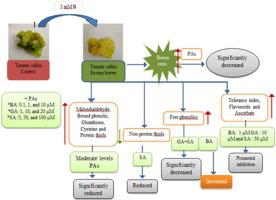当前位置:
X-MOL 学术
›
Sci. Hortic.
›
论文详情
Our official English website, www.x-mol.net, welcomes your
feedback! (Note: you will need to create a separate account there.)
The role of benzoic acid, gallic acid and salicylic acid in protecting tomato callus cells from excessive boron stress
Scientia Horticulturae ( IF 3.9 ) Pub Date : 2021-02-01 , DOI: 10.1016/j.scienta.2020.109867 Fatma A. Farghaly , Hussein Kh. Salam , Afaf M. Hamada , Abeer A. Radi
Scientia Horticulturae ( IF 3.9 ) Pub Date : 2021-02-01 , DOI: 10.1016/j.scienta.2020.109867 Fatma A. Farghaly , Hussein Kh. Salam , Afaf M. Hamada , Abeer A. Radi

|
Abstract Excess boron (EB) is a known threat to plant growth and productivity, however, the role of applications of phenolic acids [PAs; benzoic acid (BA), gallic acid (GA), and salicylic acid (SA)] in mitigating this threat has not been extensively explored. In vitro investigations were performed to realize the mechanism of PAs on the tolerance index (TI), boron (B) accumulation, and non-enzymatic antioxidants in alleviating EB on tomato (Solanum lycopersicum L. cultivar Castle Rock) calli. Tomato calli were subjected to two levels of B (medium B condition (control) and 2 mM boric acid) in the presence or absence of different concentrations of PAs. The results showed that moderate levels of BA (1.0 μM), GA (10 μM), and SA (50 μM) promoted inhibition of the TI, flavonoids, and ascorbate (AsA) of EB-treated calli. The B concentration was increased under EB, and this parameter was significantly decreased by PAs. Malondialdehyde (MDA), bound phenolics, cysteine (Cys), glutathione (GSH), and protein thiols (PTs) were increased under EB but were significantly reduced through the use of PAs. Free phenolics were increased under EB and were significantly decreased by PAs, only BA increased its content in calli. In addition, EB reduced non-protein thiols (NPTs); however, this deficiency was alleviated by PAs, only SA reduced its content. These results provide new visions to the mechanism that helps control EB in tomato plants and thus can be harnessed to develop effective plant growth stimuli.
中文翻译:

苯甲酸、没食子酸和水杨酸在保护番茄愈伤组织细胞免受过度硼胁迫中的作用
摘要 过量的硼 (EB) 是植物生长和生产力的已知威胁,然而,酚酸 [PAs; 苯甲酸 (BA)、没食子酸 (GA) 和水杨酸 (SA)] 在减轻这种威胁方面尚未得到广泛探索。进行了体外研究,以了解 PA 对耐受指数 (TI)、硼 (B) 积累和非酶抗氧化剂在减轻番茄 (Solanum lycopersicum L. cultivar Castle Rock) 愈伤组织上的 EB 的机制。在不同浓度的 PA 存在或不存在的情况下,番茄愈伤组织受到两种水平的 B(中等 B 条件(对照)和 2 mM 硼酸)。结果表明,中等水平的 BA (1.0 μM)、GA (10 μM) 和 SA (50 μM) 促进了对 EB 处理愈伤组织的 TI、黄酮类化合物和抗坏血酸 (AsA) 的抑制。B 浓度在 EB 下增加,PAs 显着降低了该参数。丙二醛 (MDA)、结合酚类、半胱氨酸 (Cys)、谷胱甘肽 (GSH) 和蛋白质硫醇 (PTs) 在 EB 下增加,但通过使用 PAs 显着减少。EB 下游离酚类物质增加,PAs 显着减少,只有 BA 增加其在愈伤组织中的含量。此外,EB 减少了非蛋白质硫醇 (NPT);然而,这种缺陷被 PA 缓解,只有 SA 减少了其含量。这些结果为帮助控制番茄植物 EB 的机制提供了新的视角,因此可用于开发有效的植物生长刺激物。和蛋白质硫醇 (PT) 在 EB 下增加,但通过使用 PA 显着减少。EB 下游离酚类物质增加,PAs 显着减少,只有 BA 增加其在愈伤组织中的含量。此外,EB 减少了非蛋白质硫醇 (NPT);然而,这种缺陷被 PA 缓解,只有 SA 减少了其含量。这些结果为帮助控制番茄植物 EB 的机制提供了新的视角,因此可用于开发有效的植物生长刺激物。和蛋白质硫醇 (PT) 在 EB 下增加,但通过使用 PA 显着减少。EB 下游离酚类物质增加,PAs 显着减少,只有 BA 增加其在愈伤组织中的含量。此外,EB 减少了非蛋白质硫醇 (NPT);然而,这种缺陷被 PA 缓解,只有 SA 减少了其含量。这些结果为帮助控制番茄植物 EB 的机制提供了新的视角,因此可用于开发有效的植物生长刺激物。
更新日期:2021-02-01
中文翻译:

苯甲酸、没食子酸和水杨酸在保护番茄愈伤组织细胞免受过度硼胁迫中的作用
摘要 过量的硼 (EB) 是植物生长和生产力的已知威胁,然而,酚酸 [PAs; 苯甲酸 (BA)、没食子酸 (GA) 和水杨酸 (SA)] 在减轻这种威胁方面尚未得到广泛探索。进行了体外研究,以了解 PA 对耐受指数 (TI)、硼 (B) 积累和非酶抗氧化剂在减轻番茄 (Solanum lycopersicum L. cultivar Castle Rock) 愈伤组织上的 EB 的机制。在不同浓度的 PA 存在或不存在的情况下,番茄愈伤组织受到两种水平的 B(中等 B 条件(对照)和 2 mM 硼酸)。结果表明,中等水平的 BA (1.0 μM)、GA (10 μM) 和 SA (50 μM) 促进了对 EB 处理愈伤组织的 TI、黄酮类化合物和抗坏血酸 (AsA) 的抑制。B 浓度在 EB 下增加,PAs 显着降低了该参数。丙二醛 (MDA)、结合酚类、半胱氨酸 (Cys)、谷胱甘肽 (GSH) 和蛋白质硫醇 (PTs) 在 EB 下增加,但通过使用 PAs 显着减少。EB 下游离酚类物质增加,PAs 显着减少,只有 BA 增加其在愈伤组织中的含量。此外,EB 减少了非蛋白质硫醇 (NPT);然而,这种缺陷被 PA 缓解,只有 SA 减少了其含量。这些结果为帮助控制番茄植物 EB 的机制提供了新的视角,因此可用于开发有效的植物生长刺激物。和蛋白质硫醇 (PT) 在 EB 下增加,但通过使用 PA 显着减少。EB 下游离酚类物质增加,PAs 显着减少,只有 BA 增加其在愈伤组织中的含量。此外,EB 减少了非蛋白质硫醇 (NPT);然而,这种缺陷被 PA 缓解,只有 SA 减少了其含量。这些结果为帮助控制番茄植物 EB 的机制提供了新的视角,因此可用于开发有效的植物生长刺激物。和蛋白质硫醇 (PT) 在 EB 下增加,但通过使用 PA 显着减少。EB 下游离酚类物质增加,PAs 显着减少,只有 BA 增加其在愈伤组织中的含量。此外,EB 减少了非蛋白质硫醇 (NPT);然而,这种缺陷被 PA 缓解,只有 SA 减少了其含量。这些结果为帮助控制番茄植物 EB 的机制提供了新的视角,因此可用于开发有效的植物生长刺激物。











































 京公网安备 11010802027423号
京公网安备 11010802027423号